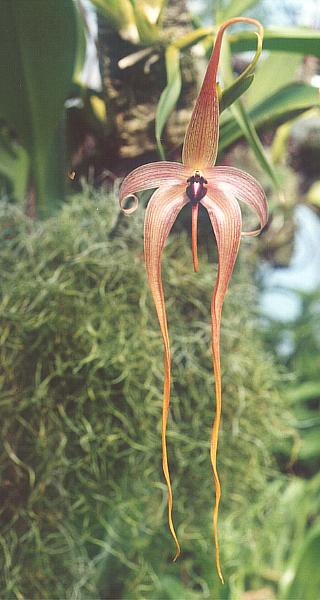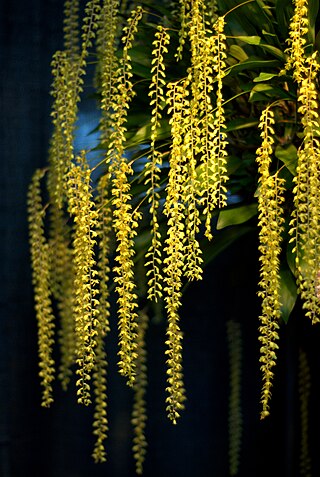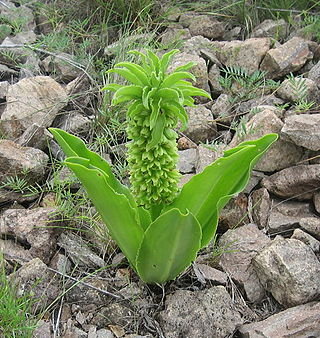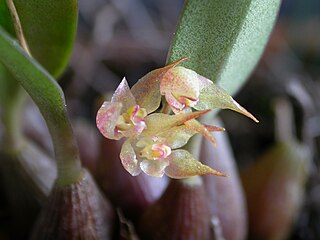
In botany, a bulb is structurally a short stem with fleshy leaves or leaf bases that function as food storage organs during dormancy.

Gymnadenia conopsea, commonly known as the fragrant orchid or chalk fragrant orchid, is a herbaceous plant of the family Orchidaceae native to northern Europe.

Bulbophyllum is a genus of mostly epiphytic and lithophytic orchids in the family Orchidaceae. It is the largest genus in the orchid family and one of the largest genera of flowering plants with more than 2,000 species, exceeded in number only by Astragalus. These orchids are found in diverse habitats throughout most of the warmer parts of the world including Africa, southern Asia, Latin America, the West Indies, and various islands in the Indian and Pacific Oceans. Orchids in this genus have thread-like or fibrous roots that creep over the surface of trees or rocks or hang from branches. The stem is divided into a rhizome and a pseudobulb, a feature that distinguished this genus from Dendrobium. There is usually only a single leaf at the top of the pseudobulb and from one to many flowers are arranged along an unbranched flowering stem that arises from the base of the pseudobulb. Several attempts have been made to separate Bulbophyllum into smaller genera, but most have not been accepted by the World Checklist of Selected Plant Families.

Dendrochilum cobbianum, or Cobb's dendrochilum, described by Heinrich Gustav Reichenbach in 1880, is an epiphytic orchid occurring in the Philippines, growing on moss-covered trees. It can sometimes occur as a lithophyte growing on rocks at altitudes above 1200 m.

Caladenia, commonly known as spider orchids, is a genus of 350 species of plants in the orchid family, Orchidaceae. Spider orchids are terrestrial herbs with a single hairy leaf and a hairy stem. The labellum is fringed or toothed in most species and there are small projections called calli on the labellum. The flowers have adaptations to attract particular species of insects for pollination. The genus is divided into three groups on the basis of flower shape, broadly, spider orchids, zebra orchids and cowslip orchids, although other common names are often used. Although they occur in other countries, most are Australian and 136 species occur in Western Australia, making it the most species-rich orchid genus in that state.

Ophrys insectifera, the fly orchid, is a species of orchid and the type species of the genus Ophrys. It is remarkable as an example of the use of sexually deceptive pollination and floral mimicry, as well as a highly selective and highly evolved plant–pollinator relationship.

Bulbophyllum fletcherianum, the tongue orchid, Fletcher's bulbophyllum or Spies' bulbophyllum, is a rare orchid native to southern New Guinea. It prefers sunny rock outcrops or mossy tree branches, but besides being lithophytic or epiphytic, it can also be pseudo-terrestrial. The tongue orchid requires high humidity and moist roots.

Prasophyllum, commonly known as leek orchids, is a genus of about 140 species of flowering plants in the orchid family, Orchidaceae and is found in Australia and New Zealand. The Australian species are found in all states but have not been recorded in the Northern Territory. The common name arises from their having a hollow, leek- or onion-like leaf. Some species only flower after summer fires and have flowers similar to those of Xanthorrhoea which flower at the same time, suggesting that they employ the same pollinating insects. Leek orchids are similar to those in the genus Genoplesium except that the free part of the leaf is cylindrical and the labellum has a solid connection to the column. They range in size from the little laughing leek orchid at about 15 cm (6 in) to the king leek orchid which grows up to 2 m (80 in) tall.

Laelia speciosa, commonly known as the Mayflower orchid, is a species of showy orchid found in area of Mexico with high elevation of 1,400 m (4,593 ft) to 2,400 m (7,874 ft). The plant is very drought resistant and can tolerate cool to warm conditions. It blooms from summer to fall, producing fragrant flowers. There are usually three to four flowers on an inflorescence.
Paphiopedilum ooii is a species of slipper orchid native to Mount Kinabalu on Borneo. It is named after Michael Ooi, a slipper orchid enthusiast from Malaysia. The plant blooms in the spring to early summer with a spike that can reach up to 2 meters and produce up to 17 flowers.

Platanthera yadonii, also known as Yadon's piperia or Yadon's rein orchid, is an endangered orchid endemic to a narrow range of coastal habitat in northern Monterey County, California. In 1998 this plant was designated as an endangered species by the United States government, the major threat to its survival being continuing land development from an expanding human population and associated habitat loss. One of the habitats of Yadon's piperia, the Del Monte Forest near Monterey, California, is the subject of a federal lawsuit, based upon endangerment of this organism along with several other endangered species.

Lycaste skinneri, also known as Lycaste virginalis, is a species of epiphyte orchid that resides in the south of Mexico, Guatemala, El Salvador and Honduras, at an average altitude of 1650 meters above sea level.

Eucomis autumnalis, the autumn pineapple flower, or autumn pineapple lily, is a species of flowering plant in the family Asparagaceae, subfamily Scilloideae, native to Malawi, Zimbabwe and southern Africa. It is a mid to late summer flowering deciduous bulbous perennial. The flower stem reaches about 40 cm (16 in), rising from a basal rosette of wavy-edged leaves. The green, yellow or white flowers are arranged in a spike (raceme), topped by a "head" of green leaflike bracts. It is grown as an ornamental garden plant and can also be used as a cut flower.

Calanthe pulchra is a species of orchid.

Pinalia floribunda is a species of orchid found in Myanmar, Thailand, Vietnam, Malaysia, Indonesia and the Philippines in montane forests at elevations of 500 to 2400 meters above sea level. It is a small to medium-sized, warm-to-cold growing epiphyte found on large trees along streams. It has erect, stem-like, narrow ellipsoid pseudo-bulbs carrying soft leaves that flower in the spring.

Bulbophyllum annandalei or Annandale's Bulbophyllum is a species of orchid in the genus Bulbophyllum in section Cirrhopetalum.

Bulbophyllum scabratum or Rough Bulb-Leaf Orchid is a species of orchid in the genus Bulbophyllum in section Eublepharon.

Genoplesium commonly known as midge orchids, is a genus of about 50 species of flowering plants in the orchid family, Orchidaceae and is found in Australia, New Zealand and New Caledonia. Midge orchids are terrestrial herbs with a single leaf at the base of the plant. They are similar to orchids in the genus Prasophyllum in that plants without flowers have a hollow, onion-like leaf. The flowers are small but often scented and attractive to their insect pollinators. There is disagreement about which species belong to this genus and some taxonomists suggest that most belong in the genus Corunastylis.

Broughtonia sanguinea, also known as blood red broughtonia is a plant in the genus Broughtonia, a member of the family Orchidaceae. It was named in 1813 by its first describer, Robert Brown, for 18th century English botanist Arthur Broughton.

Cynorkis gibbosa is an orchid species in the genus Cynorkis, endemic to forest edges and shaded rocks at altitudes of 600–1500 meters in Madagascar. Its flowers are salmon-pink or red, and about 35 mm in length. Found in Madagascar on shady granite rocks, on steep banks, seepage areas, along streams and at forest edges at elevations of 600 to 2000 meters as a small to medium-sized, warm to cool growing terrestrial herb with several elongated, villous tubers giving rise to a solitary, radical, oblong-lanceolate, purple maculate leaf that is shortly attenuate at both ends and amplexiculate basally that blooms in the mid spring through fall on a bristly granular, sometimes glabrous, densely many [10 to 40] flowered, sub-corymbiform inflorescence carrying 2 to 3 distant, cauline sheaths and having 10 mostly simultaneous flowers at any one time.



















